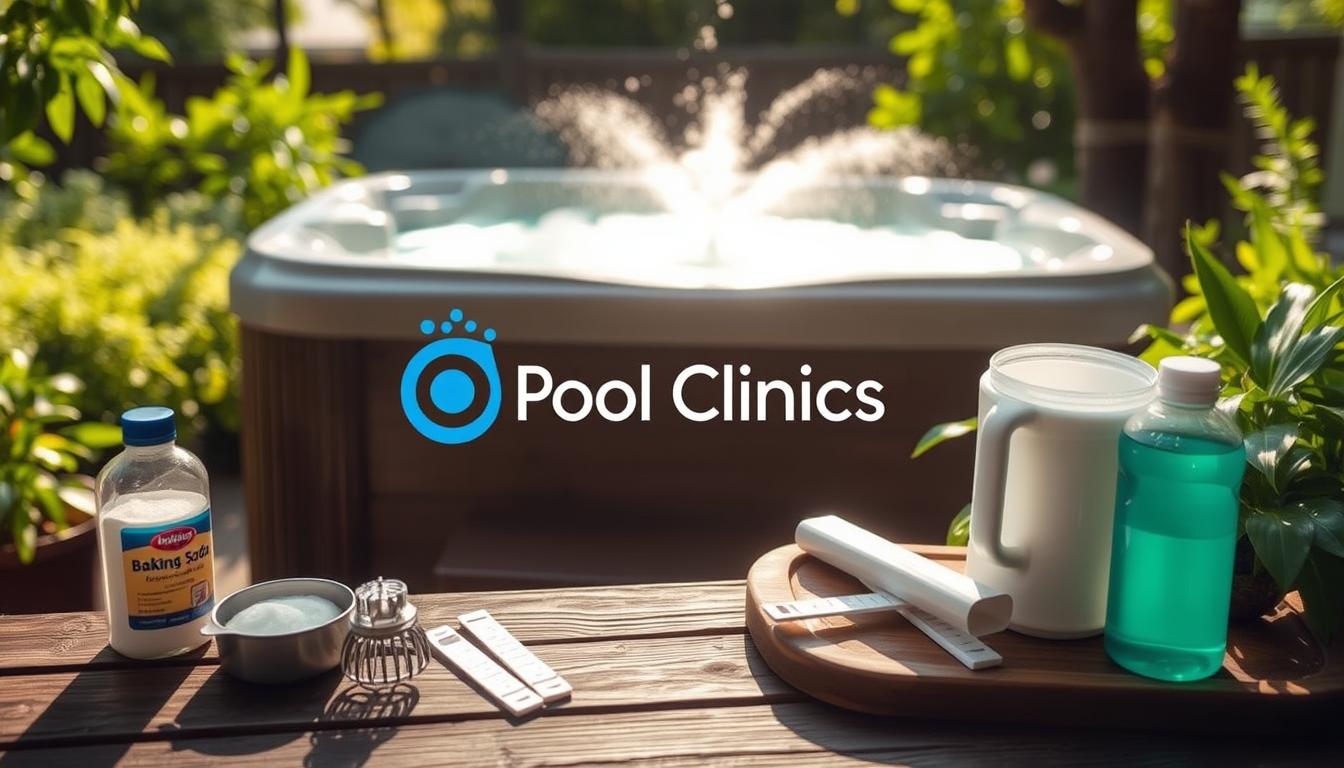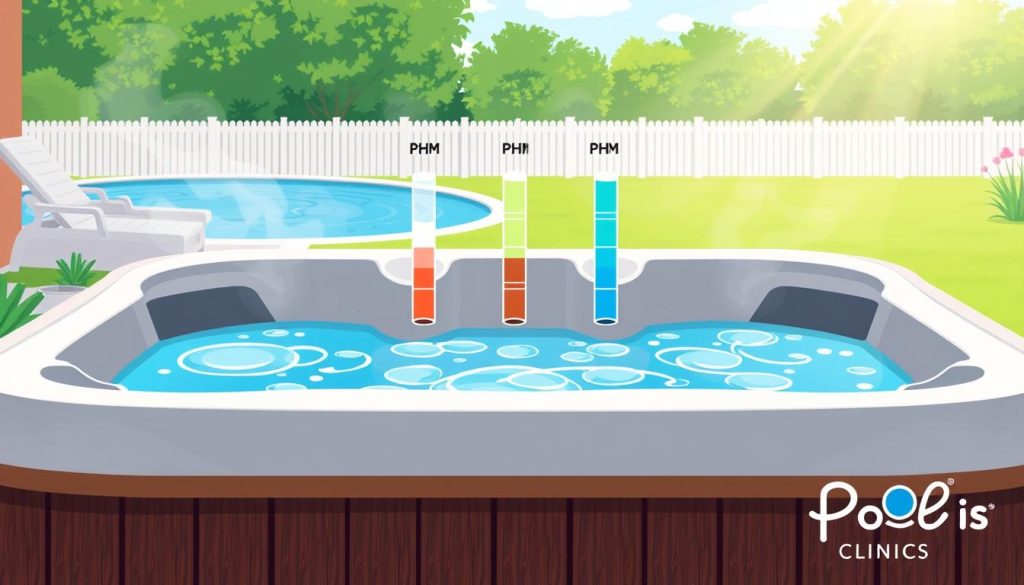
Struggling with hot tub chemistry? Baking soda can help. This guide explores using baking soda to raise alkalinity levels. It’s key for stable pH and a safe soaking experience.
Alkalinity stabilizes pH in hot tubs. It prevents rapid changes. Baking soda is a handy tool for maintaining ideal alkalinity range.
We’ll cover alkalinity’s importance and baking soda’s benefits. You’ll learn how much to add to your hot tub. This guide suits new owners and seasoned enthusiasts alike.
Master hot tub maintenance with our tips. Enjoy worry-free soaking in crystal clear water. Let’s dive in and make your hot tub experience even better!
Key Takeaways
- Maintaining proper hot tub water chemistry is crucial for a safe and enjoyable experience
- Alkalinity plays a vital role in stabilizing pH levels and preventing rapid fluctuations
- Baking soda is an effective and affordable way to raise alkalinity in hot tubs
- The ideal alkalinity range for hot tubs is between 100 and 150 ppm (parts per million)
- Regular testing and adjusting of alkalinity levels is essential for optimal hot tub maintenance
Understanding Alkalinity and Its Importance in Hot Tubs
Alkalinity is key to a healthy hot tub experience. It stabilizes pH levels in your water. Proper alkalinity ensures a safe and comfy environment for everyone.
What is Total Alkalinity?
Total alkalinity measures water’s ability to resist pH changes. It acts as a buffer against sudden acidity or basicity shifts. Proper alkalinity levels keep your hot tub water balanced.
This balance prevents issues like corrosion, scaling, and skin irritation. Regular testing helps maintain the right alkalinity levels.

Ideal Alkalinity Range for Hot Tubs
The ideal total alkalinity for hot tubs is 80-120 parts per million (ppm). This range ensures optimal pH stability and user comfort. Test your hot tub water twice a week.
Regular testing helps catch fluctuations early. This allows you to make necessary adjustments quickly.
| Alkalinity Level | Effects on Hot Tub Water |
|---|---|
| Below 80 ppm | – pH instability – Corrosion of hot tub components – Skin and eye irritation |
| 80-120 ppm | – Optimal pH stability – Comfortable water for users – Protects hot tub components |
| Above 120 ppm | – Cloudy water – Reduced sanitizer effectiveness – Scale formation on surfaces |
Effects of Low and High Alkalinity
Low alkalinity makes water prone to pH changes. This can cause various problems in your hot tub.
- Corrosion of hot tub components
- Skin and eye irritation for users
- Green water due to algae growth
- Damage to the hot tub shell and equipment
High alkalinity also creates issues in your hot tub. These problems can affect both the water and users.
- Cloudy water
- Reduced effectiveness of sanitizers
- Scale formation on hot tub surfaces
- Skin irritation and discomfort for users
Use sodium bisulfate or muriatic acid to lower high alkalinity. Baking soda can raise low alkalinity levels. Regular testing ensures a healthy hot tub environment.
Make adjustments as needed to maintain ideal alkalinity. This keeps your hot tub enjoyable for everyone.
Using Baking Soda to Raise Alkalinity in Your Hot Tub
Baking soda is a top choice for balancing hot tub alkalinity. It’s a natural alkaline substance that raises total alkalinity (TA) levels. Let’s explore why baking soda works well and how to use it effectively.
Why Choose Baking Soda?
Baking soda offers several advantages for raising hot tub alkalinity. It’s safe, natural, and eco-friendly. You can easily find it at an affordable price.
- It is a safe, natural, and environmentally friendly option
- Baking soda is readily available and affordable
- It dissolves quickly and is easy to use
- Baking soda has minimal impact on the pH levels of your hot tub water
Calculating the Right Amount of Baking Soda to Add
To determine the appropriate amount of baking soda needed to raise your hot tub’s alkalinity, follow these steps:
- Test the current alkalinity level using reliable test strips or kits
- Set your target alkalinity level between 80-120 ppm
- Calculate the adjustment needed by subtracting the current alkalinity from the target level
- Use the table below as a general guide for the amount of baking soda to add based on your hot tub’s volume and the desired increase in alkalinity
| Hot Tub Volume (Gallons) | Baking Soda Amount for 10 ppm Increase |
|---|---|
| 500 | 8.5 ounces (1/2 pound) |
| 1000 | 17 ounces (1 pound) |
Step-by-Step Guide on How Much Baking Soda to Add to Hot Tub
Once you’ve calculated the appropriate amount of baking soda, follow these steps to add it to your hot tub:
- Turn on your hot tub’s jets to ensure proper circulation
- Add the baking soda slowly, distributing it evenly across the water’s surface
- Allow the baking soda to dissolve and circulate for at least 30 minutes
- Retest the alkalinity levels after several hours and make any necessary adjustments
- Continue monitoring and adjusting the alkalinity levels as needed to maintain the ideal range of 80-120 ppm
Using baking soda to raise alkalinity keeps your hot tub water well-balanced. This ensures a safe and comfortable environment for you and your guests. Follow these steps to maintain ideal alkalinity levels in your hot tub.
Conclusion
Maintaining the right alkalinity level is crucial for a safe, comfortable hot tub experience. Baking soda is an affordable, eco-friendly solution for raising alkalinity and stabilizing pH levels. It effectively addresses issues like cloudy water, skin irritation, and corrosion.
Regular water testing helps catch imbalances early, preventing problems and extending the hot tub’s life. With knowledge and the right tools, keeping hot tub water balanced becomes simple. Proper maintenance ensures optimal performance of your investment.
Natural solutions like baking soda help create a healthy environment for everyone to enjoy. By staying proactive with cleaning and care, you’ll have a inviting hot tub for years. Your efforts will result in a safe, relaxing space for you and your loved ones.







